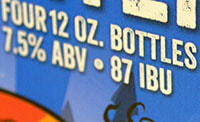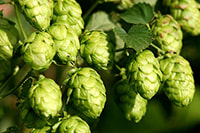IBUs (International Bittering Units) are widely shared, on tap lists, websites, apps, and beer labels. Breweries even tout the IBUs of their more aggressively bitter IPAs as a way to entice hopheads, who in turn brag about their heavily IBU-laden conquests. Despite the pervasiveness of the term, there seems to be a great deal of misunderstanding as to what an IBU actually is.

Simply put, an IBU is a measurement of the amount of isomerized alpha acid in a beer. Alpha acid is one component of hop resin and isomerization is the rearranging of a compound’s molecular structure without adding or subtracting any of those molecules. Isomerization will occur in beer brewing when heat is applied. This restructuring of the molecular arrangement of alpha acids allows the alpha acids to release all their bittering, flavor, and aroma into the beer. Therefore, the earlier hops are added during the boil, the more bitterness will be extracted. Adding hops late or even after the boil (a process called “dry hopping) will mainly add aroma.
Different hop varieties have different levels of alpha acids, measurable as a percentage of the total weight of the hop resin. A low alpha acid hop might only have 3 or 4% alpha acid while others might range as high as 17 or 18%. Obviously, these high alpha acid varieties are capable of delivering much higher IBUs. Almost all beers will have some IBUs. A light American lager like Budweiser only has a few whereas imperial IPAs can range north of 100.

So there you have it – IBUs are a fairly objective measurement of the amount of isomerized alpha acid in a beer. Where things get tricky, however, is that measuring the isomerized alpha acids in a beer doesn’t indicate perceived bitterness. In other words, knowing the IBUs in a beer won’t tell you how bitter the beer actually tastes. There are other mitigating factors, namely the malt bill and the use (if any) of adjuncts. Malt and adjuncts provide flavors that balance out the bitterness of hops. Therefore, a beer with a massive malt bill like an imperial stout might actually have more IBUs than a typical IPA but it won’t taste anywhere near as bitter because the huge malt profile drowns out the hoppiness; the hops in an imperial stout are merely providing balance, they’re not actually detectable. Only knowing the IBUs in a beer and nothing else is akin to only knowing the number of grains of salt in a bowl of soup – it doesn’t really inform you how salty the soup tastes.
I guess what I’m saying is don’t get too hung up on knowing the IBUs in a beer. It may serve as a rough guide but won’t actually indicate how bitter the beer is. Instead, I’d encourage you to ask questions and engage in conversations with beer lovers like the folks who work at Jungle Jim’s. A good beer geek will help steer you in the direction of something that serves up just the level of bitterness you’re searching for. Cheers!
Eric, Eastgate






